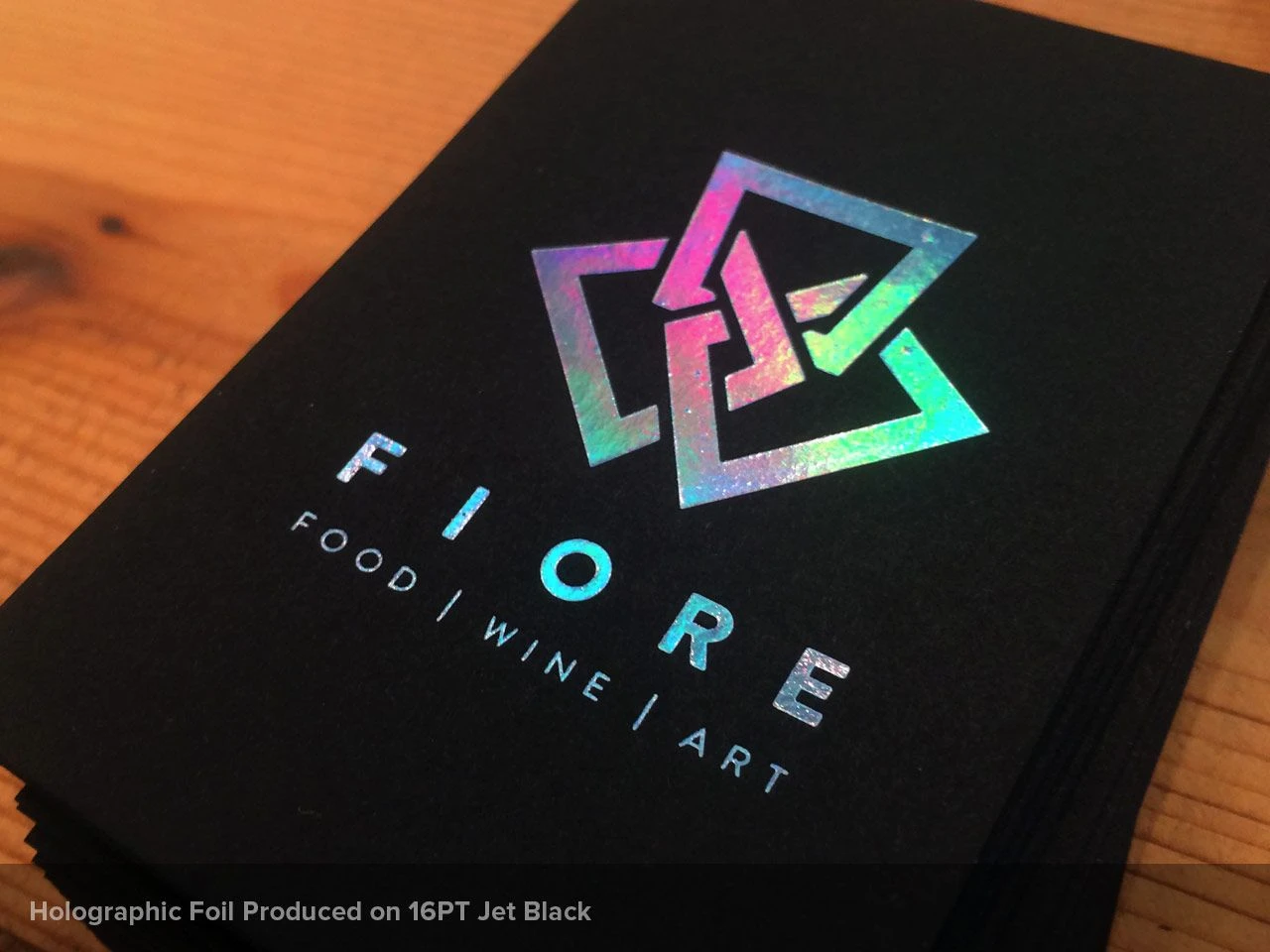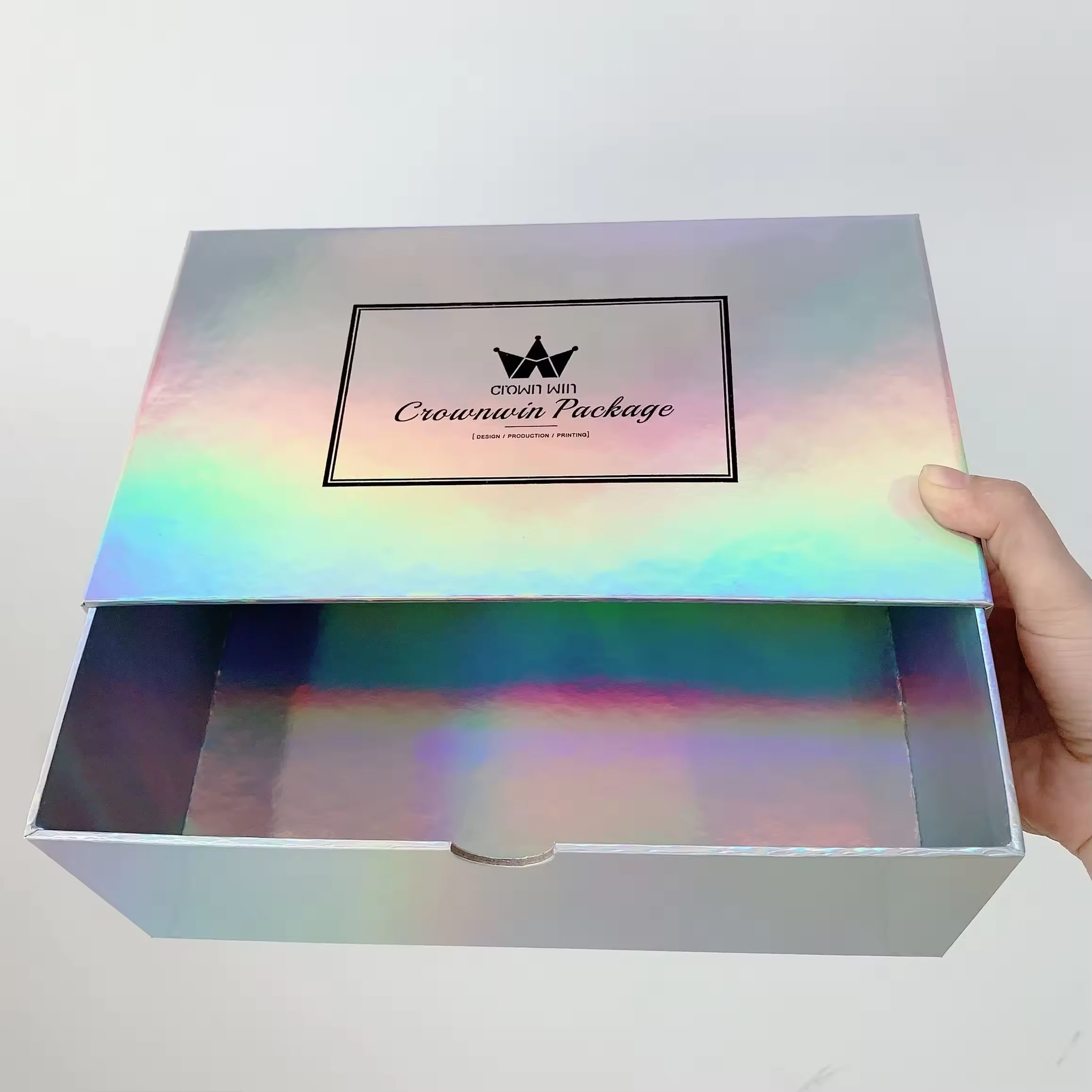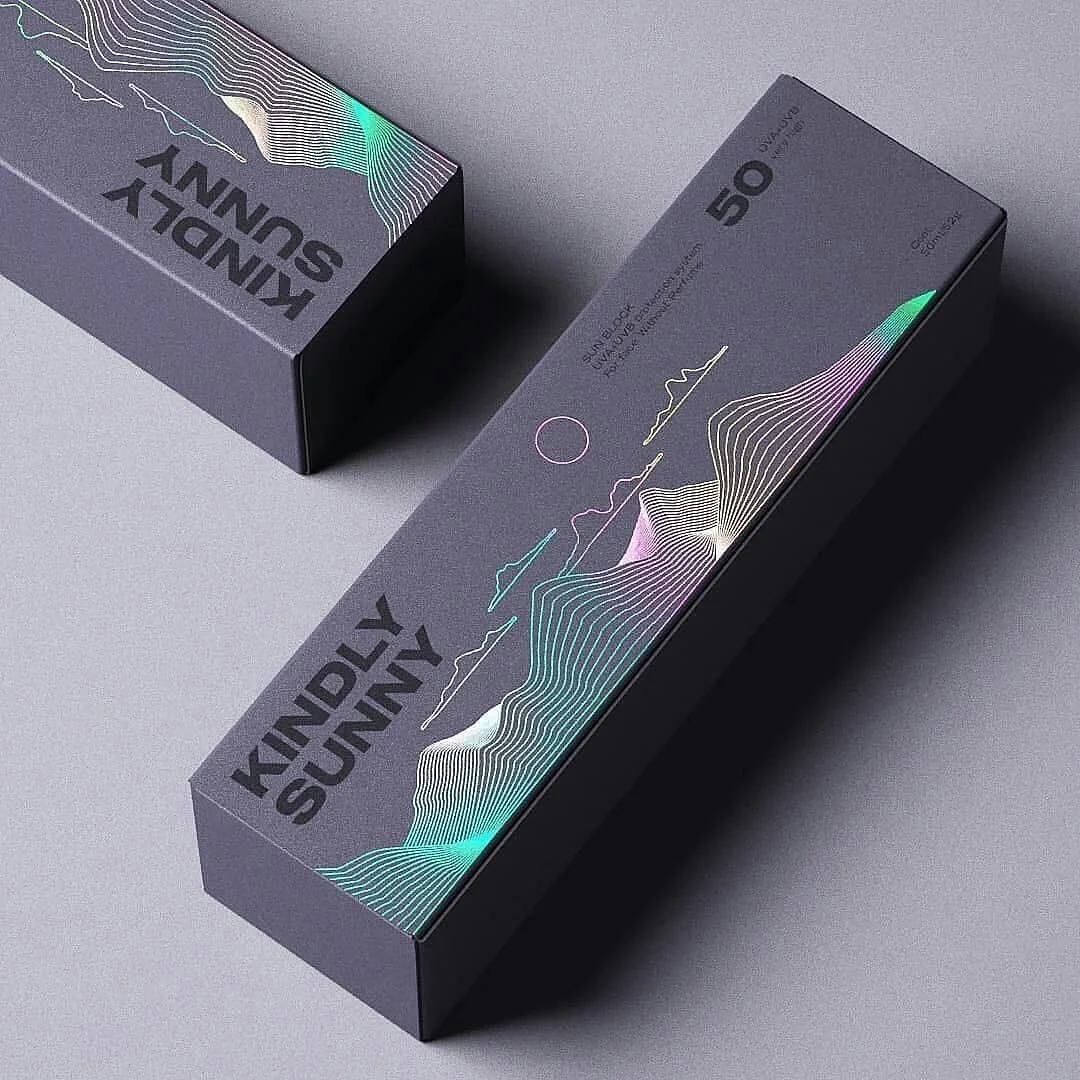In today’s competitive retail landscape, visual appeal is everything—and holographic foiling delivers just that. With its signature rainbow-like shimmer, this specialty finish instantly elevates packaging from ordinary to extraordinary.
You’ve probably noticed this effect on luxury cosmetics, custom gift boxes, or even security packaging. The magic happens when a multi-layered holographic film is heat-stamped onto packaging, producing a dynamic, light-reflective surface that changes color as you move it.
At Box Printify, we recommend holographic foil for brands looking to make a bold impression—whether on custom product boxes, promotional kits, or limited-edition packaging. Beyond aesthetics, holographic foiling also enhances perceived value, making products appear premium and exclusive.
If you’re aiming to captivate your audience at first glance, holographic foiling is the finishing touch that turns packaging into an experience.
The Basics of Holographic Foiling
Definition and Core Concepts
Holographic foiling is a decorative and functional printing technique that applies a thin layer of metallic film containing holographic patterns onto a surface. Unlike standard metallic foils that simply reflect light in a uniform manner, holographic foils create dynamic visual effects through microscopic embossed patterns that diffract light in multiple directions, producing that signature rainbow-like shimmer and three-dimensional appearance.
When you tilt a holographically foiled surface, the patterns seem to move and shift colors – an effect that’s not just beautiful but practically impossible to replicate without specialized equipment. This makes holographic foiling both an aesthetic enhancement and a security feature in many applications.
History and Evolution of Holographic Foiling
The journey of holographic technology began in the 1940s when Hungarian physicist Dennis Gabor developed the theory of holography, earning him the Nobel Prize in Physics in 1971. However, the practical application of holography in foiling didn’t gain commercial traction until the 1980s.
Initially used primarily for security applications like credit cards and banknotes, holographic foiling has evolved tremendously over the decades. What was once a highly specialized, expensive process has become more accessible to various industries. Technological advancements have expanded the range of effects, improved application methods, and reduced costs, democratizing what was once an exclusive finishing technique.
The evolution continues today with digital holographic foiling methods and environmentally friendly alternatives emerging to meet modern production needs and sustainability concerns.
How Holographic Foiling Works
The magic of holographic foiling lies in its interaction with light. Unlike regular printing that relies on pigments to absorb certain wavelengths of light, holographic foils work through light diffraction. The foil’s surface contains thousands of microscopic embossed patterns – essentially tiny prisms – that break up light into its spectrum components.
When light hits these intricate patterns, it’s reflected at different angles depending on the viewer’s position, creating that characteristic rainbow effect and illusion of depth. This is similar to how a CD or DVD reflects light, though holographic foils use much more complex and controlled patterns.
The process involves several layers working together:
- A metallized layer (typically aluminum) that provides the reflective base
- An embossed layer containing the holographic patterns
- Release coatings that allow the foil to transfer to the substrate
- Adhesive layers that ensure the foil bonds properly

Materials Used in Holographic Foiling
Types of Foils Available
The holographic foiling market offers an impressive variety of options to suit different design needs:
- Diffraction foils: The most common type, featuring regular patterns that create rainbow effects. These include:
- Lens patterns
- Kaleidoscope effects
- Sparkle finishes
- Crystal designs
- True holograms: More complex three-dimensional images that appear to have depth and can change as viewing angles shift.
- Metallic foils: Come in various colors beyond the traditional silver, including gold, copper, blue, green, and red bases.
- Transparent holographic foils: Allow the substrate color to show through while still providing the holographic effect.
- Custom holographic foils: Feature proprietary designs, logos, or specific patterns created exclusively for a brand.
The thickness of these foils typically ranges from 12 to 50 microns – thinner than a human hair – yet they create visual effects of remarkable complexity.
Substrates Compatible with Holographic Foiling
Holographic foiling works with a wide range of materials, though some accept the process better than others:
- Paper and cardboard (coated varieties work best)
- Plastics and synthetic materials
- Leather and leather-like materials
- Glass (with appropriate preparation)
- Metal surfaces
- Wood (with suitable coatings)
The substrate’s surface quality significantly impacts the final result, with smoother surfaces generally yielding better holographic effects.

Holographic Foiling Techniques
Hot Foil Stamping
Hot foil stamping represents the traditional method of applying holographic foils. This process involves:
- Creating a metal die with the desired pattern
- Heating the die to temperatures between 200-300°F (93-149°C)
- Applying pressure to press the heated die against the foil and substrate
- The heat activates the adhesive layer on the foil
- The foil transfers to the substrate in the exact pattern of the die
Hot foil stamping produces crisp, detailed results with excellent durability. It’s ideal for premium applications where quality is paramount, though it requires specialized equipment and custom dies, making it less suitable for short runs or frequent design changes.
I particularly appreciate hot foil stamping for luxury packaging and high-end business cards, where the tactile element adds another dimension to the holographic effect.
Cold Foil Application
Cold foil application emerged as a more efficient alternative to hot stamping. This process works as follows:
- UV-curable adhesive is printed onto the substrate in the desired pattern
- The holographic foil is applied over the adhesive
- The material passes under UV light, curing the adhesive and bonding the foil
- Excess foil is removed, leaving only the pattern behind
This technique offers several advantages: faster production speeds, compatibility with standard printing presses, and the ability to apply foil over previously printed areas. It’s become increasingly popular for packaging and labels where production efficiency matters.
Cold foil typically has less dimensional character than hot stamping but allows for greater flexibility in design and integration with other printing processes.
Digital Holographic Foiling
The newest entrant to the holographic foiling family, digital foiling combines digital printing technology with foil application:
- A digital printer applies a toner or liquid that attracts foil
- The foil is applied over the entire surface
- The foil adheres only to the digitally printed areas
- Excess foil is removed
Digital holographic foiling eliminates the need for custom dies, making it cost-effective for short runs, variable data, and personalized applications. While it may not match the dimensional quality of hot stamping, it offers unprecedented flexibility for projects requiring frequent design changes or personalization.
Applications of Holographic Foiling
Packaging and Product Enhancement
Packaging remains the most common application for holographic foiling, where it serves multiple purposes:
- Drawing consumer attention in crowded retail environments
- Communicating premium quality and value
- Enhancing brand recognition
- Creating memorable unboxing experiences
- Differentiating product lines within a brand family
From cosmetics and perfumes to electronics and confectionery, holographic foiling adds perceived value that often justifies higher price points. Studies suggest that enhanced packaging with features like holographic foiling can increase consumer willingness to pay by 15-30% for otherwise identical products.

Security and Anti-Counterfeiting Measures
Beyond aesthetics, holographic foiling serves crucial security functions:
- Currency protection (look at many modern banknotes)
- Secure documentation (passports, certificates, tickets)
- Product authentication (pharmaceuticals, luxury goods)
- Tamper-evident seals and closures
- Brand protection against counterfeiters
The complexity of true holographic images makes them extremely difficult to duplicate without specialized equipment, providing an effective deterrent against forgery. Many holographic security features also incorporate covert elements visible only under specific conditions (UV light, magnification, etc.), adding further protection.
Marketing and Brand Differentiation
Marketers increasingly turn to holographic foiling to make promotional materials stand out:
- Business cards that command attention
- Brochures and catalogs that engage readers
- Direct mail pieces with significantly higher open rates
- Trade show materials that draw visitors
- Limited edition promotions that create collector value
The tactile and visual appeal of holographic elements creates stronger brand recall and can significantly improve marketing ROI when used strategically.
Creative and Artistic Applications
Artists and designers continue to push the boundaries of holographic foiling in creative applications:
- Book covers and dust jackets
- Album artwork and concert merchandise
- Fine art prints and limited editions
- Fashion accessories and apparel embellishment
- Interior design elements and wall coverings
The interplay between light, movement, and holographic elements creates dynamic artworks that change with the viewer’s perspective, opening new possibilities for creative expression.
Benefits and Limitations of Holographic Foiling
Benefits:
- Visual impact: Creates eye-catching effects impossible to achieve with conventional printing.
- Perceived value: Products with holographic elements are often perceived as more premium.
- Security: Offers protection against counterfeiting.
- Differentiation: Helps products stand out in competitive markets.
- Versatility: Compatible with various substrates and other printing techniques.
Limitations:
- Cost considerations: Generally more expensive than standard printing finishes.
- Production complexity: Requires specialized equipment and expertise.
- Design limitations: Some complex designs may not reproduce well.
- Environmental concerns: Traditional foiling processes can create waste and recycling challenges.
- Overuse risk: When used excessively, can appear tacky rather than premium.
Finding the right balance is key to successful implementation. I’ve seen many projects where strategic, minimal use of holographic foiling created more impact than covering entire surfaces.
Environmental Considerations
As sustainability becomes increasingly important in production processes, the holographic foiling industry has responded with several innovations:
- Development of foils that separate more easily from paper during recycling
- Reduction in foil thickness, decreasing material usage
- Water-based adhesives replacing solvent-based options
- More efficient application methods reducing energy consumption
- Foils made from recycled materials
Despite these improvements, holographic foiling still presents recycling challenges. The metallic components can complicate paper recycling processes, though newer “eco-foils” aim to address this issue. Brands concerned with sustainability should discuss these considerations with their printers and perhaps limit foiling to smaller areas of packaging.
Cost Factors and Return on Investment
Holographic foiling represents a premium finishing technique with costs influenced by several factors:
- Size and coverage area
- Complexity of the design
- Type of foiling process used
- Run length (with economies of scale for larger runs)
- Custom vs. standard holographic patterns
- Substrate type and preparation requirements
While holographic foiling adds to production costs, many brands find the investment worthwhile when considering:
- Increased product visibility and attention
- Enhanced perception of quality
- Potential for higher price points
- Improved security and brand protection
- Stronger brand recognition and recall
For luxury products, limited editions, or security applications, the ROI often justifies the additional expense. For mass-market items, strategic use of holographic elements on key areas can provide similar benefits without proportional cost increases.
Future Trends in Holographic Foiling Technology
The holographic foiling industry continues to evolve with several exciting developments on the horizon:
- Interactive holographic elements: Integration with augmented reality applications, where holographic elements trigger digital content.
- Sustainable options: Further development of environmentally friendly foils and application methods.
- Nano-holography: Even more detailed and sophisticated effects through nanotechnology.
- Customization at scale: Improvements in digital foiling will make personalized holographic elements more affordable.
- Smart holography: Combination with conductive inks and printed electronics for functional applications beyond decoration.
These innovations suggest holographic foiling will remain relevant not just as a decorative element but as a functional component in packaging, security, and interactive applications.
Conclusion
Holographic foiling represents a fascinating intersection of art, science, and marketing. From its origins in security applications to its current widespread use in packaging, promotion, and creative expression, this versatile technique continues to captivate consumers and add value across industries.
While considerations around cost, sustainability, and appropriate application remain important, the unique visual impact of holographic foiling ensures its place in the designer’s toolkit. As technology advances, we can expect even more innovative applications that build on holographic foiling’s inherent appeal while addressing current limitations.
Whether you’re looking to enhance a product’s shelf appeal, secure important documents, or create memorable marketing materials, holographic foiling offers possibilities that standard printing simply cannot match. The key to success lies in purposeful application—using this special effect where it adds genuine value rather than as a mere decoration.
FAQs
No, they're different techniques. While metallic foiling simply applies a solid metallic finish, holographic foiling incorporates microscopic embossed patterns that create rainbow-like effects and the illusion of movement when viewed from different angles. Holographic foils contain diffraction gratings that split light into its spectrum components, creating much more dynamic visual effects than standard metallic foils.
While holographic foiling works with many substrates, not all materials accept it equally well. Smooth, non-porous surfaces like coated paper, cardboard, and certain plastics typically yield the best results. Porous or heavily textured materials may require special preparation or alternative application methods. Always consult with your printer about compatibility with your specific substrate.
Hot foil stamping creates a very durable finish that resists scratching and fading better than many other decorative techniques. Cold foil application typically offers slightly less durability but still performs well under normal handling conditions. The durability also depends on the substrate, adhesive quality, and environmental exposure. For items requiring exceptional durability, protective coatings can be applied over holographic foiling.
Traditional holographic foiling presents some recycling challenges due to the metallic components and adhesives used. However, the industry has developed more environmentally conscious options, including thinner foils, separable foils that detach during recycling, and water-based adhesives. If environmental impact is a concern, discuss "eco-foil" options with your printer and consider limiting foiling to smaller areas of your design.
Stock holographic patterns are pre-made designs available from foil manufacturers, including general effects like rainbows, stars, or geometric patterns. They're more affordable and readily available. Custom holographic patterns are created specifically for a client, often incorporating brand elements, logos, or unique designs that serve as both decoration and security features. Custom patterns require more initial investment but offer exclusive branding and security benefits impossible with stock patterns.

